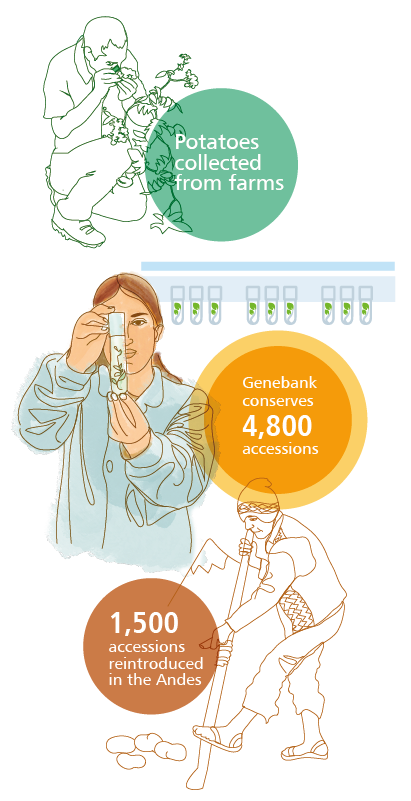The CIP genebank safeguards the world’s largest in vitro potato collection – more than 4,800 genetically unique accessions – conserved as tiny plants in refrigerated test tubes or frozen tissue cuttings, making it a world leader in the cost-effective, long-term technology of cryopreservation. The Center uses that genetic diversity to breed robust, resilient and nutritious varieties, and shares it globally.
Since 1997, the genebank has also reintroduced 1,519 native potato accessions to Andean communities in Peru, giving nearly 150,000 seed tubers to 135 communities that requested them. Not only do those potatoes replace landraces lost to pests, disease or weather extremes, CIP technicians have cleaned them of viruses that commonly infect the crop and reduce yield.
“While the genebank’s main role is to conserve biodiversity and share it with researchers under the International Treaty on Plant Genetic Resources for Food and Agriculture, this program ensures that farmers also benefit directly from our work,” says Vania Azevedo, who heads the CIP Genebank and Biodiversity for the Future Program.
A study in 65 communities that benefited from this program published in CABI Agriculture and Bioscience confirmed that many farmers continue to grow those landraces years after receiving them, though most lose them within four years. According to Sophia Lüttringhaus, the article’s lead author, women and farmers aged 60 and older conserved those landraces the longest, whereas accessions given to male household heads, or farmers under the age of 29, were less likely to survive.
Despite the loss of some reintroduced landraces, Lüttringhaus notes that the long-term relationship CIP has established with rural communities is exceptional.
“This is a highly beneficial, dynamic program that has established a circular exchange between the genebank and communities,” Lüttringhaus says. “Not only do the communities benefit from healthy potato seed and greater on-farm diversity, but scientists have also discovered landraces that weren’t in the genebank’s potato collection.”
Potato portfolios
In many Andean communities, smallholders grow 50 or more native potato landraces in the same plot. That diversity provides varied culinary and nutritional qualities, as landraces contain different levels of vitamins and minerals. It also increases farmer resilience, since landraces have varied tolerance to diseases, pests or environmental stressors. Nevertheless, those threats inevitably eliminate some varieties from farmers’ plots, which makes conservation and reintroduction important for Andean communities.
René Gómez, the genebank’s potato curator and a co-author of the study, launched efforts to return native potato diversity to Andean communities in 1997, in San José de Aymará. As the initiative expanded, San José de Aymará became a multiplication hub, growing accessions from the genebank to produce virus-free seed potatoes for distribution nationally.
According to Nelissa Jamora, an agricultural economist with the Global Crop Diversity Trust and another co-author, whereas genebanks usually repatriate varieties following natural disasters, CIP has partnered with communities to help them cope with recurring threats and increase the biodiversity on their farms.
“On-farm crop diversity is essential. We know from many cases how disastrous it can be for agrifood systems when farms are homogenous. One disease can wipe out livelihoods in a short period of time,” Jamora says.
Multiple benefits
Higher yields and on-farm diversity have multiple benefits. By forging alliances with non-profit organizations and government programs, farmers in San José de Aymará formed a cooperative and opened a business, Agropia, which produces native potato chips and other products for national and export markets.
Gómez explains that farmers who plant virus-free seed potatoes enjoy higher yields, and because Andean farmers’ traditionally sell or trade seed potatoes with others in their areas, farmers in communities beyond those reached by program have benefited from healthy seed and greater potato diversity.
“Every year, representatives of new communities contact me to request seed potatoes for landraces they’ve lost,” says Gómez. “Many farmers in the high Andes know about this program and want to participate in it.”
“We are very proud of this initiative,” says Azevedo. “It is a win-win collaboration for farmers and the genebank.”
Funders: Deutsche Gesellschaft für Internationale Zusammenarbeit; Government of Norway; Global Crop Diversity Trust.
Key partners: Asociación Andes; Asociación de Comunidades del Parque de la Papa; Comunidad de San José de Aymará.
Associated CGIAR Research Programs and Platforms: Roots, Tubers and Bananas; Genebank.


